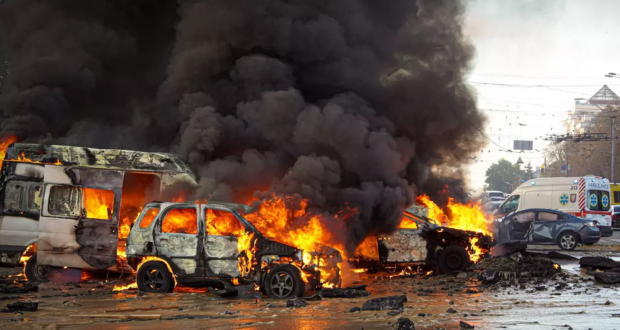By Sam Biden, Junior Fellow
24 July, 2025
In a stark reversal of earlier progress, 2022 marked the end of a steady decline in global civilian deaths that had persisted since the adoption of the 2030 Agenda for Sustainable Development (ASD). The OHCHR reports a significant surge in conflict-related fatalities, culminating in a 40 percent increase in 2024 alone. That year, at least 48,384 civilians and individuals whose status could not be determined were killed in armed conflict, the third consecutive annual increase. Between 2023 and 2024, the toll on women and children intensified sharply with deaths among these groups quadrupling relative to the previous two-year period (2021–2022), with UN records indicating 21,480 women and 16,690 children killed globally. The disproportionate weight of these casualties fell on Gaza, where 80 percent of child deaths and 70 percent of female deaths recorded in global conflict zones occurred.
This sharp and continual rise in civilian deaths ultimately comes down to two conflicts, Russia-Ukraine and Israel-Palestine.
Russia-Ukraine
Since the full-scale invasion began in February 2022, civilian casualties in Ukraine have followed a consistently high trajectory. March 2022 recorded the deadliest month of the war to date with 4,289 civilian deaths, falling to 1,905 in April and 1,145 in May. Child casualties mirrored this spike, peaking at 511 in March before falling into double digits throughout the remainder of the conflict period. The overwhelming majority of these deaths were caused by explosive weapons with wide-area effects, including artillery shelling, air-dropped bombs and loitering munitions launched from drones. Over a two-year span from 2022 to 2024, the UN documented 8,898 civilian deaths and 18,818 injuries from such weapons, with 486 of those deaths being children. The gendered dimension mentioned by the OHCHR points to differential exposure as more men than women and children remained in frontline zones, accounting for their higher casualty rate. In parallel, landmines and explosive remnants of war claimed 343 lives and injured 769 people in areas that have long been vacated by the colliding forces.
Between March and May 2024, at least 436 civilians were killed and 1,760 injured, including a high level of humanitarian personnel. 96 percent of casualties were caused by explosive weapons in populated areas, with a small proportion resulting from mines and explosive remnants, with only 9 percent of total casualties occurring in Russian territory. May 2024 emerged as the most violent month since June 2023, with 174 civilians killed and 690 injured. The intensification of Russian ground operations in the Kharkiv region played a significant role in this spike, with many notable strikes to follow on the horizon. Key attacks accompanied the Russian advance, with a 23 May missile strike on a Kharkiv printing house that killed seven and injured 21, the 25 May bombing of a home improvement store that left 19 dead and 54 wounded and a missile attack on residential buildings that killed nine civilians and wounded at least 15 on 31 May. In total, hostilities in Kharkiv between 10 and 31 May killed 78 civilians and injured 305 more.
The September–November 2024 period continued this pattern of elevated civilian harm, with September alone registering the highest number of civilian casualties since July 2022. Of the 574 civilians killed and 3,082 injured during this time, 98 percent were victims of wide-area explosive weapons deployed in populated zones, with the regions of Donetsk and Kharkiv being targeted the most. Attacks in the regions accounted for 72 percent of the casualties as Russian aerial glide bombs were newly deployed in Zaporizhzhia city for the first time in late 2024, marking a concerning expansion of high-yield bombardments into previously unaffected urban areas. Little positives came from the next reporting period with figures from December 2024 to May 2025 remaining critically high. Although the initial winter months saw a temporary dip, the situation escalated again in March and April 2025, being fronted with drone strikes by Russian forces in Kherson and Odesa, bringing civilian deaths and injuries to levels comparable with late 2024. By May, 968 civilians were killed and another 4,807 injured, a 37 percent increase compared to the same span a year earlier.
Short-range drones caused the most civilian casualties from December 2024 through February 2025. During this reporting period alone, these attacks killed 207 civilians and injured 1,365, with 96 percent of these casualties recorded in Ukraine. Attacks in occupied regions of Ukraine also increased, causing 17 deaths and 51 injuries by February. Hopes of improvement were dampened come May, with record numbers resurging. At least 183 civilians were killed and 836 injured across 17 regions, including Kyiv and previously untargeted urban areas, as seen in the tail end of 2024. May’s casualty count was the second highest of the year. Of the month’s total casualties, 28 percent were linked to missile or loitering munitions strikes, another 28 percent to short-range drone attacks, 21 percent to artillery and MLRS shelling and 18 percent to aerial bombardments.
Israel-Palestine
With accusations of genocide looming against Netanyahu’s Israeli government, drastic civilian harm has been confirmed by the warring parties. However, with Israel’s reluctance to provide accurate data on the total civilian death toll in Gaza, conflicting information from the Gaza Health Ministry (GHM), operated under the jurisdiction of Hamas, has arisen. Civilian fatalities in Gaza surged to unprecedented levels in late 2023, with November marking the deadliest month on record following the 7 October attacks. Daily death tolls approached 750 as hostilities intensified, before declining to under 300 per day following the start of 2024. However, two subsequent waves of escalated air raids by the IDF reignited the death toll in June 2024 and March 2025, with the latter pushing fatalities beyond 450 per day. By May 2025, the Gaza Ministry of Health had compiled a list of 52,958 unique deaths attributed to the conflict.
This list represented a major overhaul in data reporting by GHM. Previous versions of the death toll had included fewer entries than the total figures claimed, prompting external skepticism, despite general praise from international bodies regarding GHMs previous recorded data. The updated list, however, shows a near-complete dataset boasting a 99.96 percent of the recorded deaths now including essential identifying information such as name, sex, age, date of birth and a valid national ID number. This reflects a prolonged administrative effort to reconcile the list as criticism in April last year surrounding the incompleteness of GHMs database had exceeded 17 percent, falling to near zero percent by May this year. Despite the improvements in data accuracy, the list’s validity remains a subject of scrutiny. GHM itself has acknowledged flaws in thousands of cases, including the inability of independent observers to confirm that each ID number corresponds to the correct individual, with difficulty to identify compounded by recovered bodies being in too poor condition, often due to wide area explosives, causing issues with verification. For the GHM to overcome this, a cooperative system allowing access with the Palestinian population registry, a private registry of Palestinians, would need to be made. The May 2025 data further indicates that 40,044 fatalities were recorded through hospitals and morgues, while 12,914 were submitted online by family members, a method particularly vulnerable to duplication or error, requiring external validation to ensure the accuracy of the data. These figures reflect an ongoing tension between the urgency of documenting wartime deaths and the challenge of preserving data reliability under siege conditions, only worsened by attacks on medical facilities.
The IDF campaign in Gaza has increasingly targeted medical infrastructure, often with devastating consequences for civilians. These attacks cause multiple issues; the ability of Palestinians to receive immediate medical aid, increasing the distance to medical aid for those in affected areas and direct inflation of the death toll. The broader pattern of attacks on healthcare infrastructure reveals systematic targeting. According to the WHO, from 7 October 2023-30 July 2024, the IDF conducted 498 attacks on medical facilities in Gaza, resulting in 747 deaths and 969 injuries, damaging or destroying 110 facilities. The WHO found that 78 percent of the incidents involved direct military force, 35 percent entailed obstruction of access and 9 percent featured militarized searches or detentions.
The collapse of the healthcare system under pressure from the continual siege, alongside shortages of humanitarian aid, has dramatically heightened mortality rates. As of July 15, 2024, only 16 of Gaza’s 36 hospitals remained partially operational and 20 were fully non-functional. Those still open were severely overcrowded, with a combined capacity of just 1,490 beds, unable to accommodate the never-ending waves of new casualties. Beyond direct strikes against the facilities themselves, shortages of fuel and electricity have stalled medical machinery, while the repetitive blockades of humanitarian aid have curtailed access to fix such issues. Furthermore, in the absence of reliable sanitation, facilities have become breeding grounds for infection, causing indirect deaths as no reliable form of treatment can be offered. Compounding this is the now inevitable deprioritizing that must be made by medical staff, placing the needs of those with chronic illnesses below more immediate cases, leading to preventable complications and deaths.
The use of hospitals as both humanitarian and military spaces has become one of the most fiercely contested aspects of the war. Israeli forces have repeatedly alleged that over 85 percent of Gaza’s major medical facilities were co-opted by Hamas for military operations. While hospitals have verifiably doubled as civilian shelters, such as the Shifa and Quds hospitals sheltering some 50,000 and 12,000 civilians in conditions that intensified the risks of both overcrowding and direct targeting with claims of military use remaining contested. These claims include allegations of tunnel infrastructure beneath hospitals, weapons caches stored within wards and the presence of armed personnel and command centers. The IDF cited Shifa and Nasr hospitals as a key example, releasing footage of a tunnel entrance approximately 100 meters from the hospital’s main building and claiming to have found weapons inside the maternity ward during a raid in February and March last year. Yet these allegations have been met with firm denials by hospital staff and Palestinian officials. The OHCHRs Commission of Inquiry conducted interviews with senior medical personnel who rejected any suggestion of armed activity within hospital grounds, insisting that their role was strictly humanitarian, being supported by Hamas repeatedly denying using hospitals for military purposes. Nonetheless, testimonies from several released hostages indicate they were held within medical complexes, though the circumstances remain unverified.
In the occupied West Bank, WHO recorded 520 assaults on health facilities from 7 October 2023-30 July 2024. The IDF have been accused of using excessive force and infiltration tactics. The methods of attack were varied and increasingly severe, most notably the controversial 30 January raid on Jenin’s Ibn Sina Hospital, during which undercover Israeli personnel disguised as doctors and Palestinian women executed three Palestinian men inside the hospital, an incident that drew condemnation from humanitarian organizations. The IDF also carried out airstrikes on hospitals, besieged medical complexes and blocked humanitarian access to those affected, effectively leaving civilians trapped inside facilities under fire after being issued evacuation orders without safe passage. In totality, the human toll on the medical community has been grave – as of 23 June 2024, 500 medical workers have been verifiably killed, according to the GMH, alongside 19 members of the Palestine Red Crescent Society.
Conclusion
Recent conflicts in Ukraine and Gaza have led to a marked increase in civilian casualties, highlighting a broader trend in which warfare increasingly unfolds in populated areas with limited regard for civilian safety. The scale and persistence of these incidents suggest a diminishing influence of established norms meant to protect non-combatants, calling into question the adequacy of current mechanisms for oversight and compliance in modern conflict settings.
Image: Kyiv after a Russian attack, 10 October 2022 (Source: Main Directorate of the State Emergency Service/kyiv.dsns.gov.ua/CC BY 4.0)
 Human Security Centre Human Rights and International Security Research
Human Security Centre Human Rights and International Security Research




